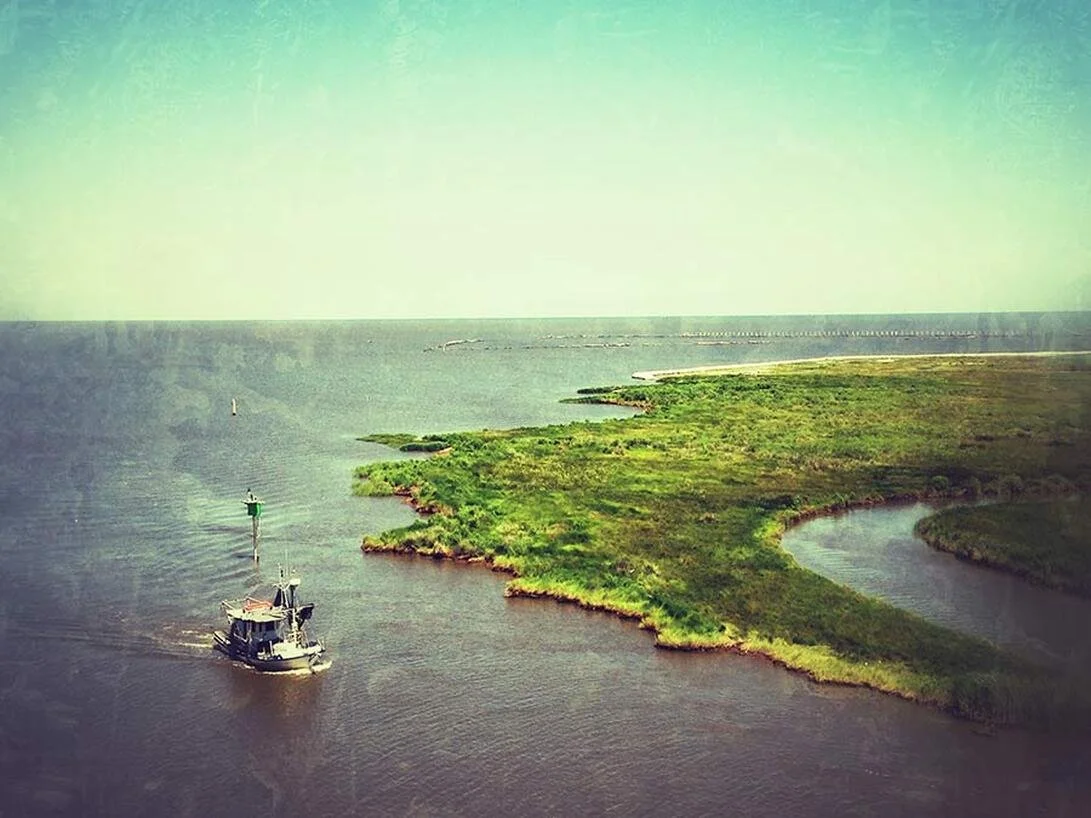A Rousing New Anthology: The Gulf South
Bayou Cadet, looking out into the Mississippi Sound. Book review photos by Ellis Anderson
Even regional literary connoisseurs are likely to discover new favorites in the first powerhouse anthology of Gulf Coast environmental writing, edited by Tori Bush and Richard Goodman.
- by John Sledge
In his elegiac 2007 book, Terra Incognita: Photographs of America’s Third Coast, Richard Sexton wrote that the long, gracefully curving shore between the Florida Keys and the Rio Grande “has eluded our national psyche.” He chalked this phenomenon up to the hell-for-leather obsession with manifest destiny, intent “on uniting the Atlantic seaboard and Pacific coast, while the Gulf Coast (the archetypal middle child) languished.”
Others have noted this neglect as well, none more effectively than environmental writer and historian Jack E. Davis, who declared in his Pulitzer Prize-winning 2017 book, The Gulf: The Making of an American Sea, that the region has been “wholly excluded from the central narrative of the American experience.”
Davis’s genius was to inextricably link the Gulf’s prodigious natural environment to its human history and destiny. Eschewing “traditional historical narrative that leaves humans gamboling across unacknowledged landscapes,” Davis instead placed nature at the heart of his big book. Not simply a stage set, it became a “catalyst” that explained wars, economies, and settlement patterns.
Davis extolled the Gulf’s “nourishing energy” and charted humankind’s tragic abuse of its natural abundance. The future, he warned, is potentially dire — overdevelopment, pollution, accelerating climate change, and sea level rise.
As Davis so clearly demonstrated, the Gulf is a critical national asset that should be treated with care and protected. The United States extracts a quarter of its natural gas and one sixth of its oil from the Gulf, claims 14 of the basin’s 19 major ports, harvests 1.4 billion pounds of seafood annually from its waters (20 percent of the total U.S. commercial fishery), and logs millions of recreational fishing trips a year. The five Gulf coastal states (Florida, Alabama, Mississippi, Louisiana, and Texas) boast surging beach tourism and overall growth rates two and a half times the national average.
Unfortunately, as a business writer joked some years ago, when the region does get noticed it’s usually for its embarrassing politics and vulnerability to natural disasters.
If the broader public does not appreciate the Gulf’s significance, it is certainly not due to a lack of books. There is plenty of good writing about the region available. But heretofore it never occurred to anyone to anthologize this material.
Happily, two New Orleanians have rectified this oversight. Tori Bush, a doctoral candidate in English at Louisiana State University, and Richard Goodman, an associate professor of creative nonfiction writing at the University of New Orleans and author of French Dirt: The Story of a Garden in the South of France (2002), are the editors of a thoroughly enjoyable new work, The Gulf South: An Anthology of Environmental Writing (University Press of Florida).
In their introduction, Bush and Goodman briefly examine the differences between environmental writing, “a mode in which writers and readers respond to the era’s environmental, social, and cultural crisis”; nature writing, a meditative endeavor that “does not necessarily depend on science, politics, or cultural contexts”; and ecocriticism, an academic enterprise that delves into how nature is handled in literature. While there is much overlap among these sister genres, the ultimate purpose of environmental writing is to “rouse the reader.”
Their topic chosen and defined, the editors’ greatest challenge was what to include. To that end they polled more than 60 scientists, journalists, and scholars, and received over 300 recommendations. Since environmental writing is a relatively recent response to conditions in the Gulf South, the bulk of these suggestions dated from the 1920s forward.
Ultimately the editors settled on 40 pieces encompassing an incredibly rich sampling of fiction, nonfiction, reportage, poetry, and even a graphic novel, Josh Neufield’s A.D.: New Orleans after the Deluge (2010). They included three late-19th-century samples in the mix, among them Lafcadio Hearn’s powerful 1889 novel Chita: A Memory of Last Island, to altogether salutatory effect.
Otherwise, the selections include Zora Neale Hurston (Their Eyes Were Watching God, 1937), William Faulkner (The Wild Palms, 1939), Marjory Stoneman Douglas (The Everglades: River of Grass, 1947), John McPhee (“Atchafalaya,” 1989), John Barry (Rising Tide, 1997), Oliver Houck (Down on the Batture, 2010), Jesmyn Ward (Salvage the Bones, 2011), Edward O. Wilson (Half-Earth: Our Planet’s Fight for Life, 2016), and Jack E. Davis, to name just a few.
Storm, flood, and toxic corporations are recurrent themes, fulfilling the editors’ desire for pieces that “explore the changing culture between humans and the Gulf South environment.” Most of the writers one would expect are here, and almost half of them are women.
That said, as with any such effort there are imbalances. Florida and Louisiana rate the most pieces, 10 for the former and 18 for the latter, with the Mississippi River and the Everglades looming large. Texas, owning 332 miles of coastline, scores just five selections, while Mississippi (44 miles) also gets five, and Alabama (32 miles) a paltry two.
Granted, Alabama’s coastline is the shortest, but the Mobile River delta is a natural wonder that inspired Edward O. Wilson, who dubbed it “an American Amazon.” It is also the subject of some fine journalism by former Mobile Register reporters Bill Finch and Ben Raines that richly deserves wider recognition.
Almost completely offstage throughout is the Gulf of Mexico itself. A piece by Antonia Juhasz, “Thirty Million Gallons Under the Sea” (2015) takes the reader offshore and beneath the waves, and Jack E. Davis details the bays, rivers, and barrier islands encountered by the Spanish conquistadores Panfilo de Narváez and Cabeza de Vaca. Some authors whose inclusion would have injected a little more brine are Elizabeth Rush (Rising: Dispatches from the new American Shore, 2018), Archie Carr (The Windward Road, 1956), and Peter Jenkins (Along the Edge of America, 1995).
None of this should detract from what is a solid effort. As the editors themselves note, “this is an anthology of environmental writing from the Gulf South, not the anthology.” Even Gulf Coast literary connoisseurs will likely discover new favorites in these pages, while those not already familiar with writers like John Barry and Jesmyn Ward are in for one hell of an introduction.






